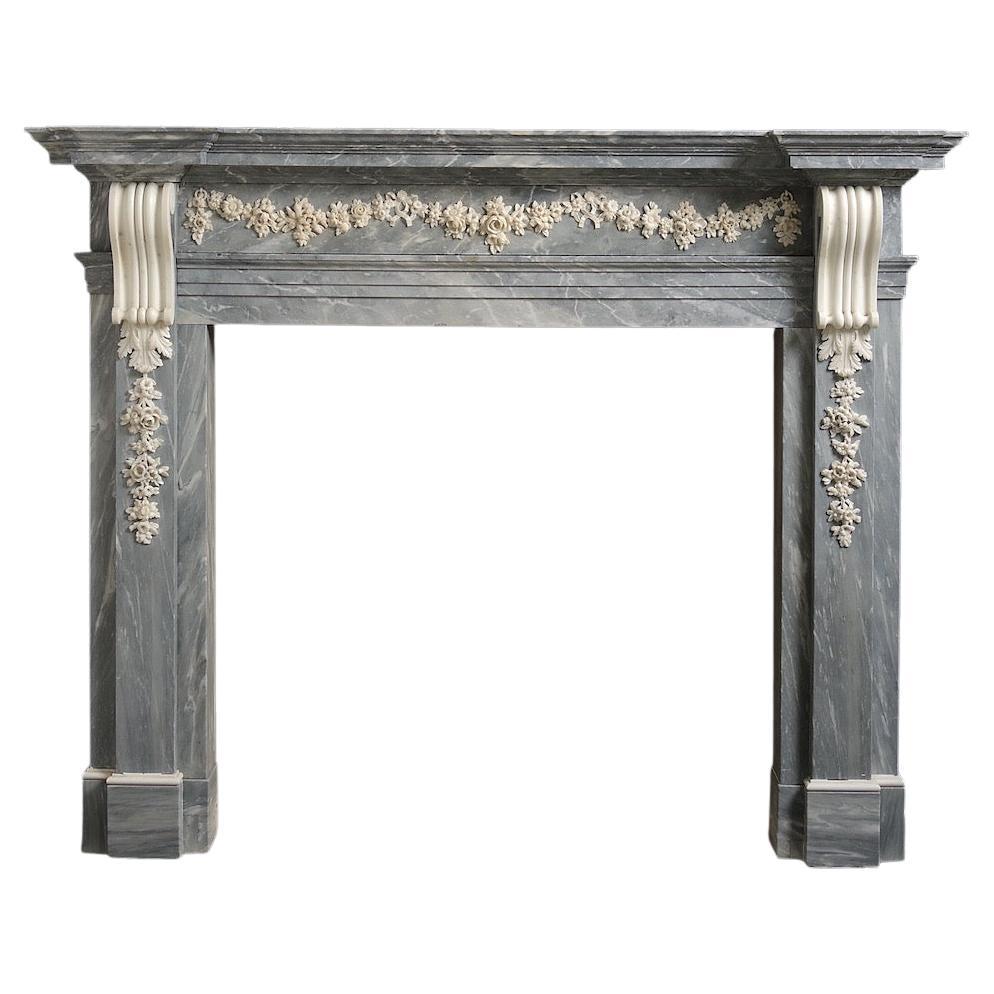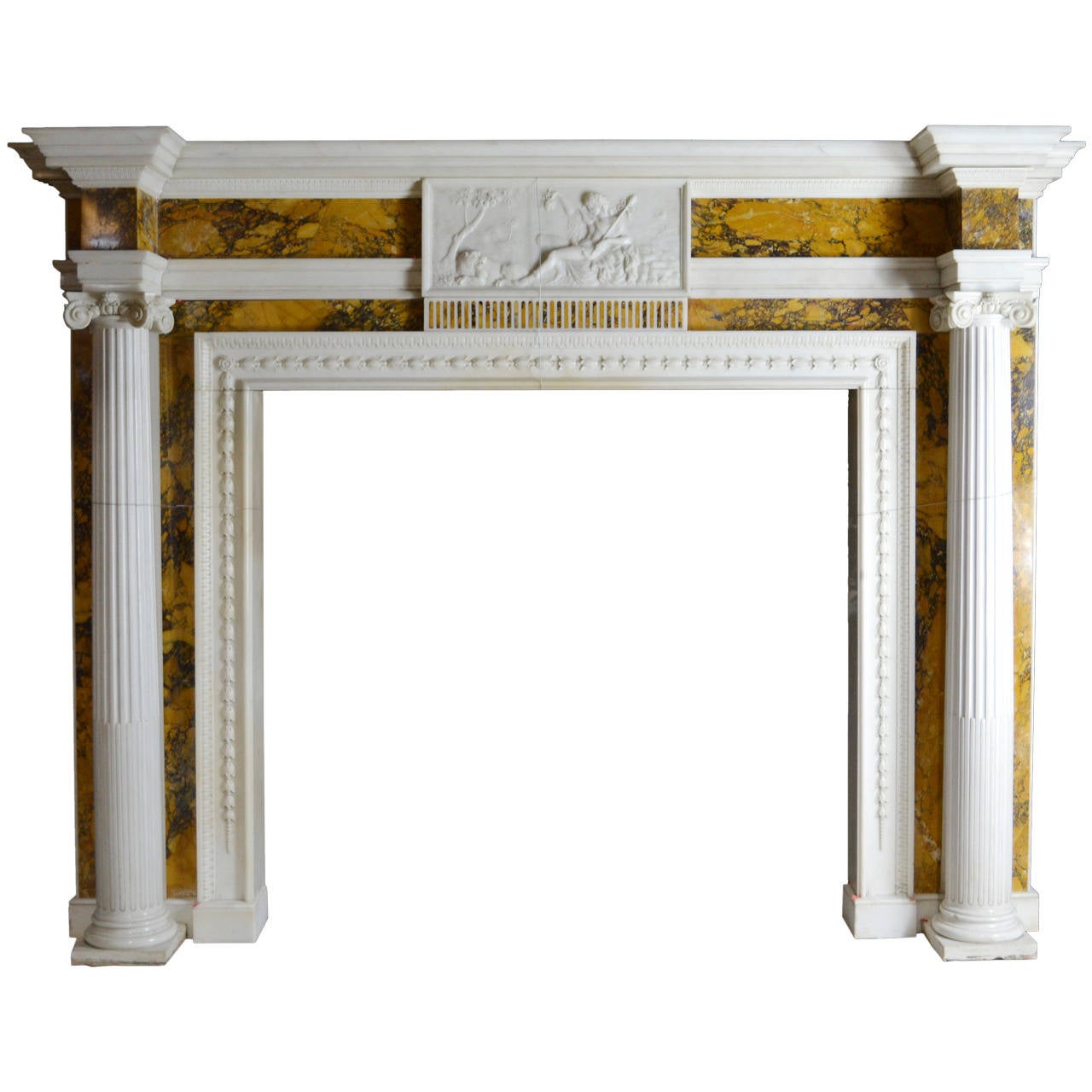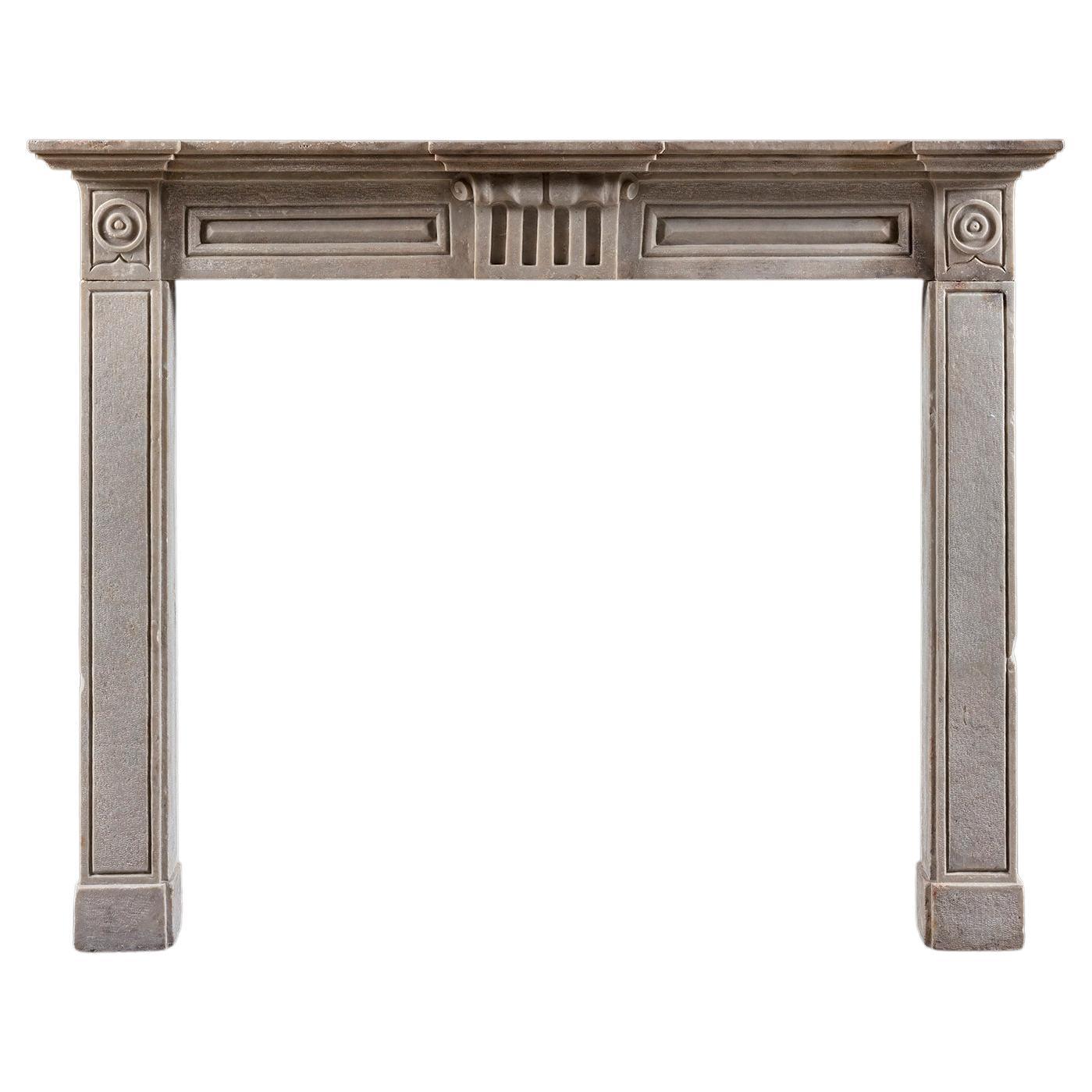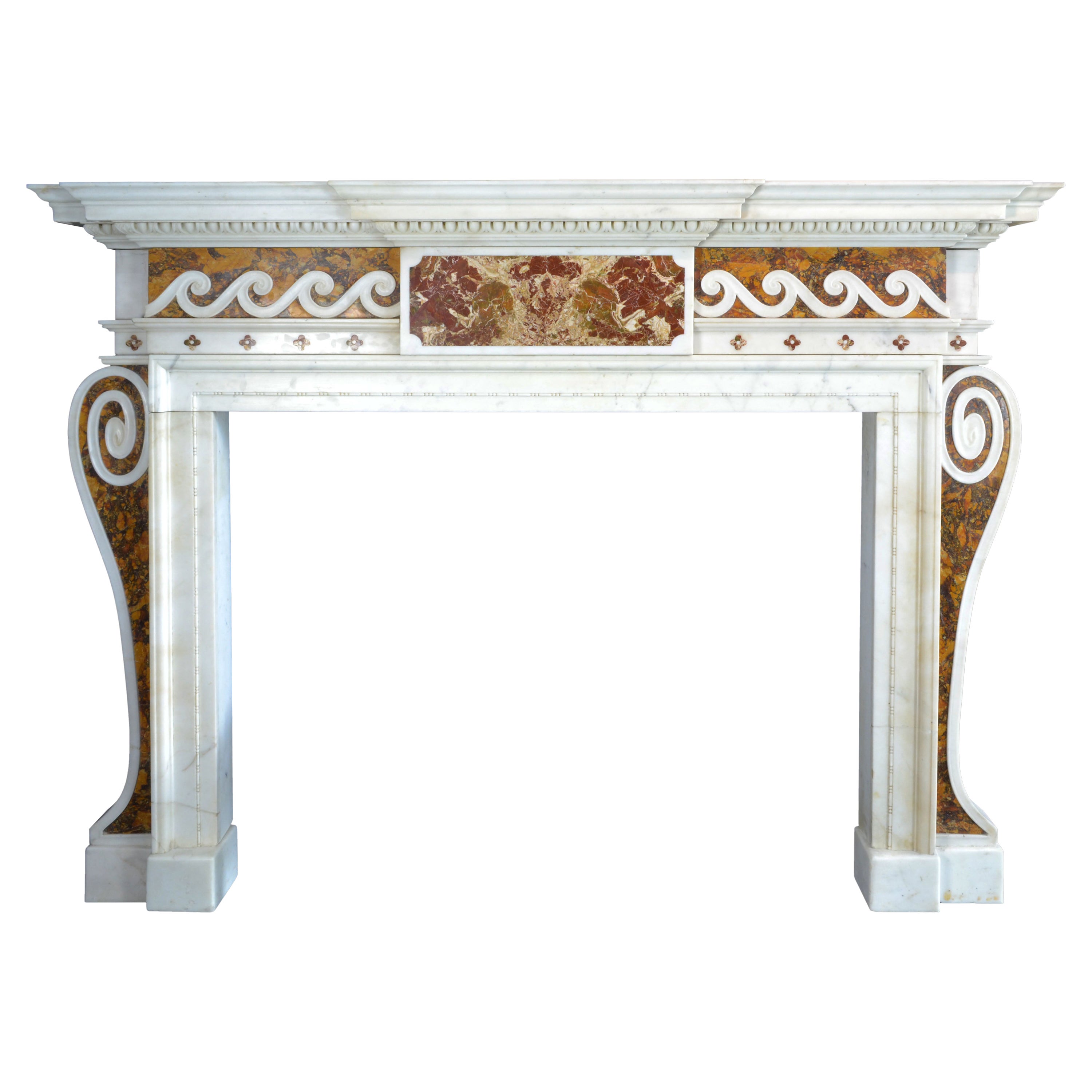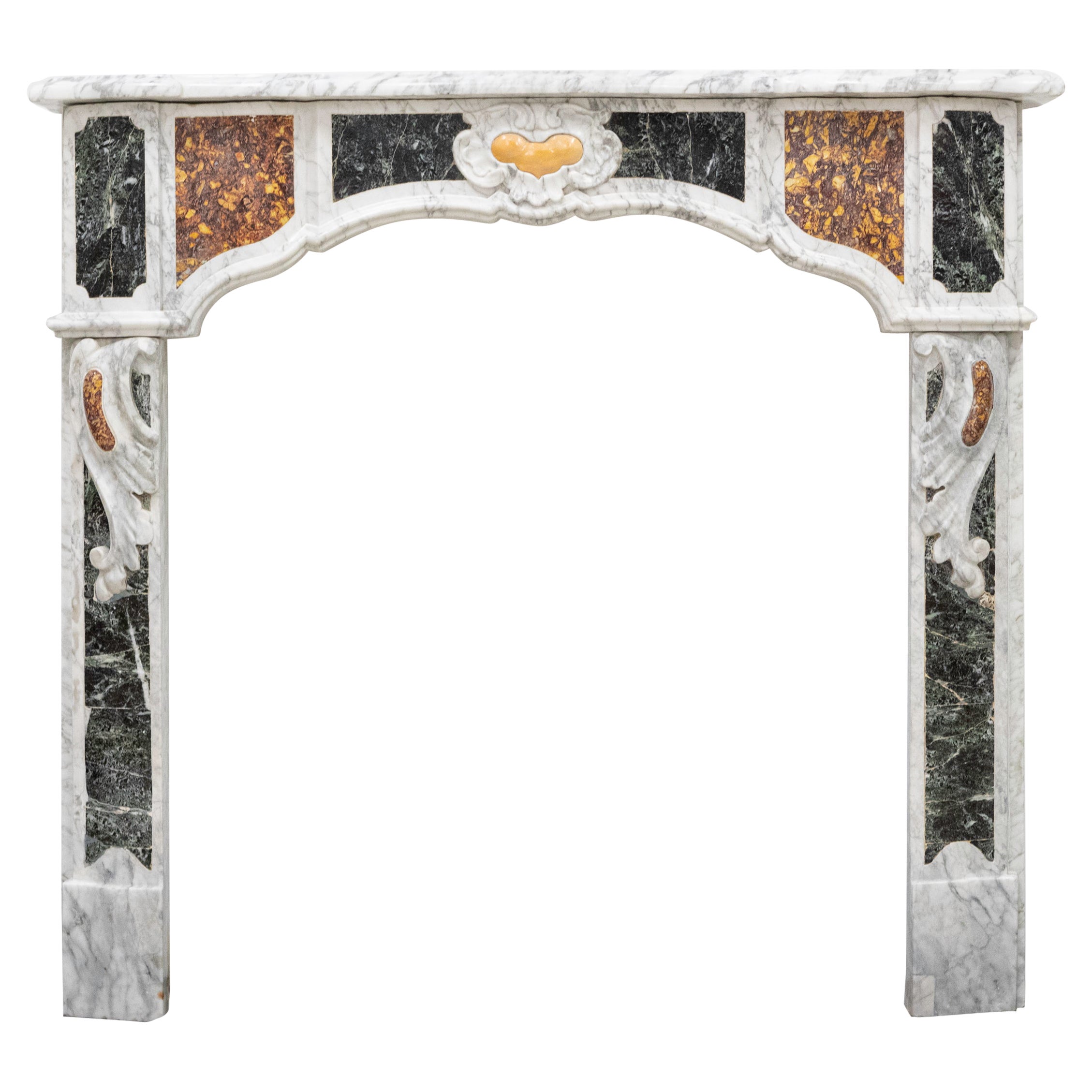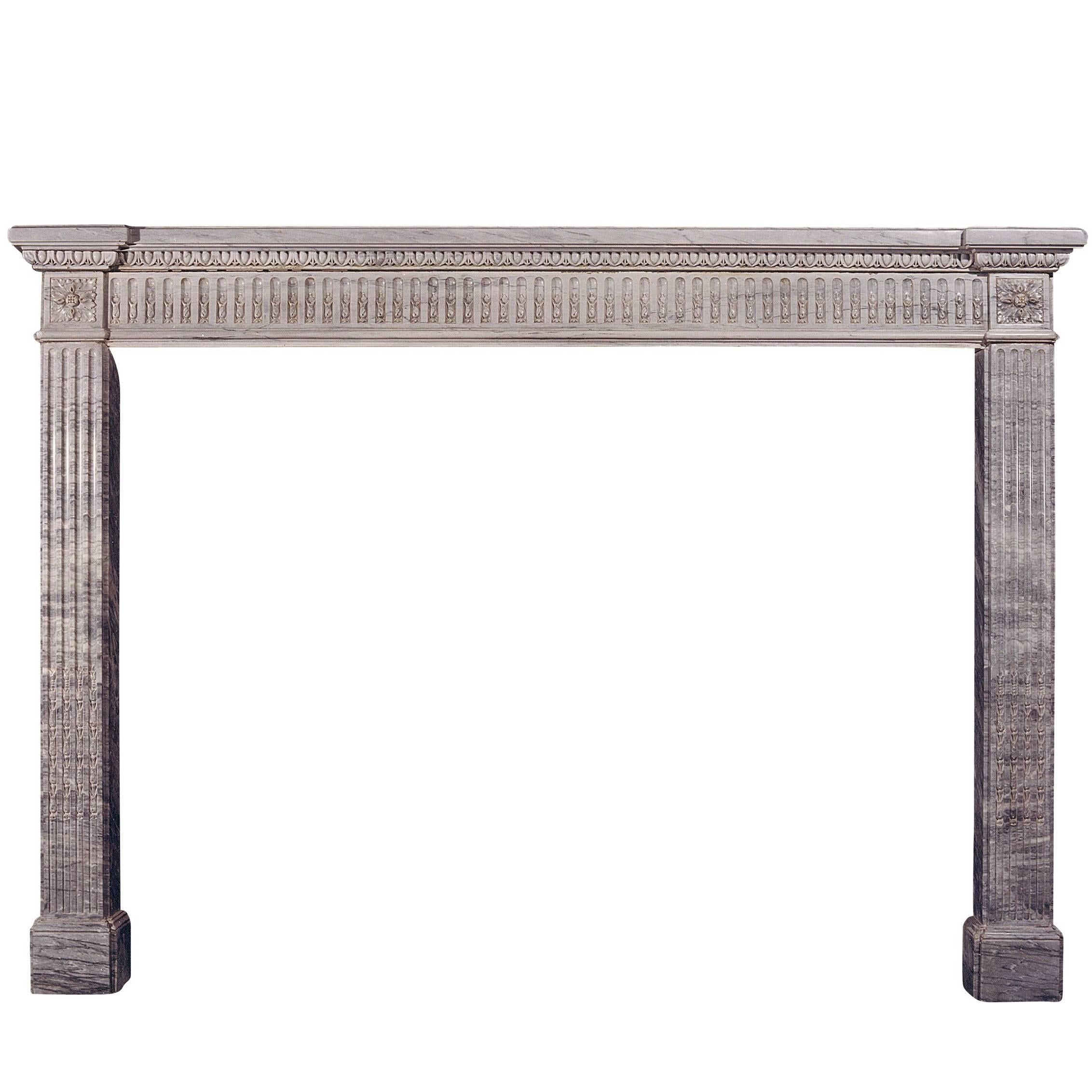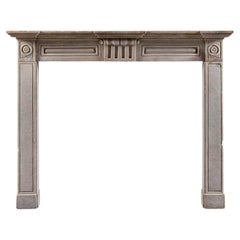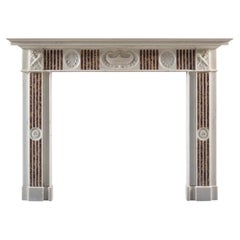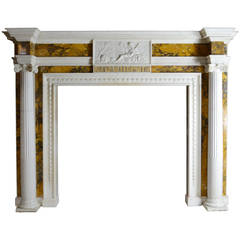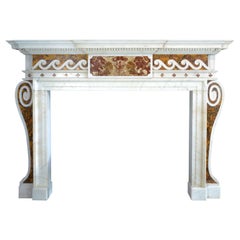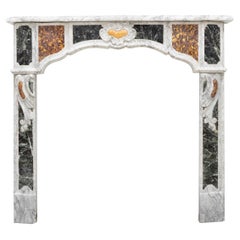Items Similar to 18th Century Marble Chimneypiece by Renowned Architect James Paine (1717-1789)
Want more images or videos?
Request additional images or videos from the seller
1 of 9
18th Century Marble Chimneypiece by Renowned Architect James Paine (1717-1789)
About the Item
An Extremely Refined 18th Century Chimneypiece in White Statuary Marble by the Renowned Architect James Paine (1717–1789)
A moulded breakfront shelf with lambs tongue and leaf and dart mouldings. This is upheld by a frieze showing alternating Greek ornament palmettes and lotus motifs, defined by Paine as “Palmyra Ornaments”. Rams heads, supported by fluted tapered pilaster jambs, are surmounted by diagonally set volutes.
Provenance
Lord Melbourne’s London House, No. 28 Sackville street; Acquired by Gustave Leven (owner of Perrier water) before 1970 for Château de la Croix des Gardes, Cannes; Private collection, France.
Further details
A drawing from Paine’s book "Plans, Elevations and Sections of Noblemen and Gentlemen’s Houses" (London 1783) attests that the chimneypiece was designed and carved for Lord Peniston Lamb Melbourne’s London house, No.28 Sackville street, where Paine was employed as an architect between 1769 and 1774. No.28 is the largest house on the street; the internal decorations date to the 1730s, and only the chimneypieces can be attributed to Paine.
Aged eighteen, Paine set out for London, determined to join the St. Martin’s Lane Academy, an institution founded by Hogarth in 1735. At St Martin’s, Paine’s coterie included the architect Isaac Ware (1704–1766) who taught him how to merge the avant-garde Rococo style with the well-established canons of Palladianism. Ware further introduced Paine to the third Earl of Burlington, a crucial connection who was soon to provide the young architect’s first commission.
By 1750, Paine’s London practice was thriving thanks to Burlington’s address book. Paine also inherited a number of commissions from the architect Daniel Garrett, making 1753–54 a very profitable few years, during which he also met his most important patron, Sir Hugh Smithson, baronet of Stanwick. First as Duke and later as the Earl of Northumberland, he embarked upon a programme of re-decorating his properties. Paine’s major project for the Duke was Alnwick castle, which occupied him for 15 years.
In August 1755, Paine’s relative fame enabled him to down his pencil and take a Grand Tour to Italy. His trip lasted just under a year, and, unlike his rivals Robert Adam and William Chambers, he travelled as an established architect and not a young pupil. Therefore, whereas Adam and Chambers arrived in Italy as impressionable young architects, Paine couldn’t help but absorb the classical canons through the lens of his previously acquired knowledge gained while working in Britain.
Upon his return, two more connections, the Duke of Devonshire and the Duke of Norfolk, led to Paine undertaking important work at Chatsworth and Kedleston Hall. After this, Paine’s good fortune continued to grow, which saw him expand into new areas of the country. In Hertfordshire for example, he worked on Brockett Hall for his patron Sir Matthew Lamb and in 1760, he became director of the Society of Artists, founded in order to showcase in London his own work and that of his peers, such as William Chambers and Joshua Reynolds.
During this time, he focused on the first volume of "Plans, Elevations and Sections of Noblemen and Gentlemen’s Houses", published in 1767. In over seventy beautifully executed engravings, he illustrated his most prestigious work, proclaiming his ability as established architect. In the preface to the first volume, he expresses his aversion towards the ‘Greek style’ and, more generally, the archaeological studies popular at the time. His strong opinions on the architect’s education caused controversy in his circles, but this did not prevent him from obtaining new commissions, such as work on Salisbury Street.
His role at the Society of the Artists became more prominent when a defecting group split from the society in 1768 due to internal feuding, primarily between Chambers and Paine himself. The defectors went on to found the Royal Academy.
Interior decoration was an important aspect of Paine’s career, and, as Chambers noted, chimneypieces were a particular speciality. Until he opened his own workshop on the Tottenham Court Road in the 1760s, he had his chimneypiece designs made by leading craftsmen such as Thomas Carter. His starting point in design was the strong tradition of Anglo-Palladianism inherited from Inigo Jones through the work of Campbell and Kent. Paine merged these foundations adeptly with the French Rococo style he was an avid proponent of throughout his life. This innovative combination became his new and unique style, best expressed in his chimneypieces. He incorporated mid-eighteenth century architectural elements such as columns, plaques, volutes, pedimented overmantels into his chimneypieces with singular delicacy. The most distinguished motif of his fireplaces is the tapered pilaster, which made his compositions slender and elegant.
The present chimneypiece can be compared to those executed from the 1760s onwards, when the tapered half pilaster appeared for the first time. It can specifically be compared to the pieces in the Blue Room at Raby Castle, at Serlby Hall, Weston Park and more. This is also when the decorative element, the ‘Palmyra Ornament’ was first introduced, as shown on the Weston Park chimneypieces and re-proposed here. The rams head theme can also be found on the Drawing Room chimneypiece at Workshop Manor, embedded in a much heavier Rococo composition. The present chimneypiece is Paine’s magnificent classical design, resisting Rococo embellishment, and successfully obtaining a restrained Palladian chimneypiece without slipping into the decorative language of Neoclassicism.
Height 59in (150cm)
Shelf width 88½in (225cm)
Depth 13in (33cm)
- Creator:James Paine (Maker)
- Dimensions:Height: 59.06 in (150 cm)Width: 88.59 in (225 cm)Depth: 13 in (33 cm)
- Style:Palladian (Of the Period)
- Materials and Techniques:
- Place of Origin:
- Period:
- Date of Manufacture:circa 1750
- Condition:Repaired. Wear consistent with age and use.
- Seller Location:London, GB
- Reference Number:Seller: G4381stDibs: LU848140548022
About the Seller
No Reviews Yet
Vetted Professional Seller
Every seller passes strict standards for authenticity and reliability
Established in 2001
1stDibs seller since 2008
33 sales on 1stDibs
Typical response time: 17 hours
- ShippingRetrieving quote...Shipping from: Mitcham, United Kingdom
- Return Policy
Authenticity Guarantee
In the unlikely event there’s an issue with an item’s authenticity, contact us within 1 year for a full refund. DetailsMoney-Back Guarantee
If your item is not as described, is damaged in transit, or does not arrive, contact us within 7 days for a full refund. Details24-Hour Cancellation
You have a 24-hour grace period in which to reconsider your purchase, with no questions asked.Vetted Professional Sellers
Our world-class sellers must adhere to strict standards for service and quality, maintaining the integrity of our listings.Price-Match Guarantee
If you find that a seller listed the same item for a lower price elsewhere, we’ll match it.Trusted Global Delivery
Our best-in-class carrier network provides specialized shipping options worldwide, including custom delivery.More From This Seller
View AllA Rare Late 18th Century Italian Chimneypiece in Marble
Located in London, GB
A well proportioned and rare Italian chimneypiece, carved in the region of Piedmont towards the end of the 18th century. A simple breakfront shelf is resting on a panelled frieze car...
Category
Antique Late 18th Century Italian Fireplaces and Mantels
Materials
Marble
A Unique 18th Century Palladian Chimneypiece in Parcel-Gilt and Portoro Nero
Located in London, GB
The central frieze is carved with a Rococo vase of flowers, flanked by scrolling motifs. This supports a broken pediment with acanthine modillions to the under-mould. The opening fra...
Category
Antique 18th Century English Palladian Fireplaces and Mantels
Materials
Marble
An 18th Century Neoclassical Marble Chimneypiece with Spanish Brocatelle Inlays
Located in London, GB
An Exceptionally Finely Carved 18th Century Chimneypiece of Neoclassical Design in White Statuary Marble with Spanish Brocatelle Inlays
From the Collection of Will Fisher at Jamb, L...
Category
Antique 18th Century English Neoclassical Fireplaces and Mantels
Materials
Statuary Marble
A Mid-18th Century Carved Pine Chimneypiece
Located in London, GB
The moulded shelf richly carved with egg and dart, above a barrel frieze carved with running laurel bound in ribbon, unusually running left–to–right rather than symmetrically from th...
Category
Antique Mid-18th Century English Fireplaces and Mantels
Materials
Pine
An Early 18th Century George I Irish Kilkenny Marble Frame Chimneypiece
Located in London, GB
With a fluted keystone, flanked by fielded panels to the frieze, on original footblocks.
Height 57¾in (146.7cm) width 54in (134cm)
Internal height 48½in (123.4cm) width 36in (91.3cm...
Category
Antique Early 18th Century Irish George I Fireplaces and Mantels
Materials
Marble
An 18th Century Italian Chimneypiece in Bardiglio Marble with Rococo Mascaron
Located in London, GB
A mid 18th century fireplace of good proportions, the serpentine shelf and frieze end in octagonal cornerblocks. Small bunches of laurel leaves hung from ribbons run down the jambs. ...
Category
Antique Mid-18th Century Italian Rococo Fireplaces and Mantels
Materials
Marble
You May Also Like
Chimneypiece Designed By James Paine (1717–1789)
Located in London, GB
AN IMPORTANT GEORGE III DOVE-GREY AND STATUARY MARBLE CHIMNEY-PIECE, DESIGNED BY JAMES PAINE (1717–1789), CIRCA 1765.
Aperture 50in.(127cm) high x 54in.(137cm) wide.
Provenance:
Ax...
Category
Antique 18th Century Fireplaces and Mantels
Materials
Marble, Statuary Marble
18th Century Irish Chimneypiece
Located in New York, NY
An imposing late 18th century Irish chimneypiece in Italian statuary with richly colored and strongly veined Convent Siena marble inlay, circa 1790....
Category
Antique Late 18th Century Irish Georgian Fireplaces and Mantels
Materials
Marble, Siena Marble
$235,500
Mid-18th Century English Chimneypiece
Located in New York, NY
An important mid-18th century English chimneypiece of strong architectural form, with many hallmarks of the work of Sir Henry Cheere. In Statuary, Convent Siena and Sicilian Jasper...
Category
Antique 1740s Fireplaces and Mantels
Materials
Siena Marble, Statuary Marble
18th Century French Provençal Carrara Brocatelle & Verde Marble Chimneypiece
Located in Ware, GB
18th Century French Provençal Carrara Marble Fireplace with Brocatelle and dark Verde marble to frieze and jambs. Carved motif to centre of frieze.
Elegant carved arch to the top of...
Category
Antique 18th Century French French Provincial Fireplaces and Mantels
Materials
Marble
18th Century French Louis XVI Dove Grey Marble Chimneypiece
Located in London, GB
An 18th century French Louis XVI dove grey marble fireplace, with carved husks to flutes, fluted jambs surmounted by pateras, and carved egg and dart moulding under shelf.
Measure:
...
Category
Antique 18th Century French Louis XVI Architectural Elements
Materials
Marble
Exceptionally Rare 18th Century Chimneypiece by Robert Adam in Statuary Marble
By Robert Adam
Located in London, GB
An exceptionally rare chimneypiece by Robert Adam.
This chimneypiece is an exciting new discovery. Commissioned by General John Burgoyne (1722-1792) for the eating room of his Londo...
Category
Antique 1760s English Neoclassical Fireplaces and Mantels
Materials
Statuary Marble
Recently Viewed
View AllMore Ways To Browse
Antique Chambers
18th Century Chateau
Marble Well Head
18th Century Book French
Rams Head Carved Furniture
Mid Century Book Shelf
Garden House Plans
Carved Lamb
White Marble Plaques
Thomas Earl
Greek Marble Head
Antique Canon
Antique Canons
Garden Well Head
Marble Plaque Italian
Marble Greek Column
Antique Furniture Building Plans
Mid Century Breakfront
